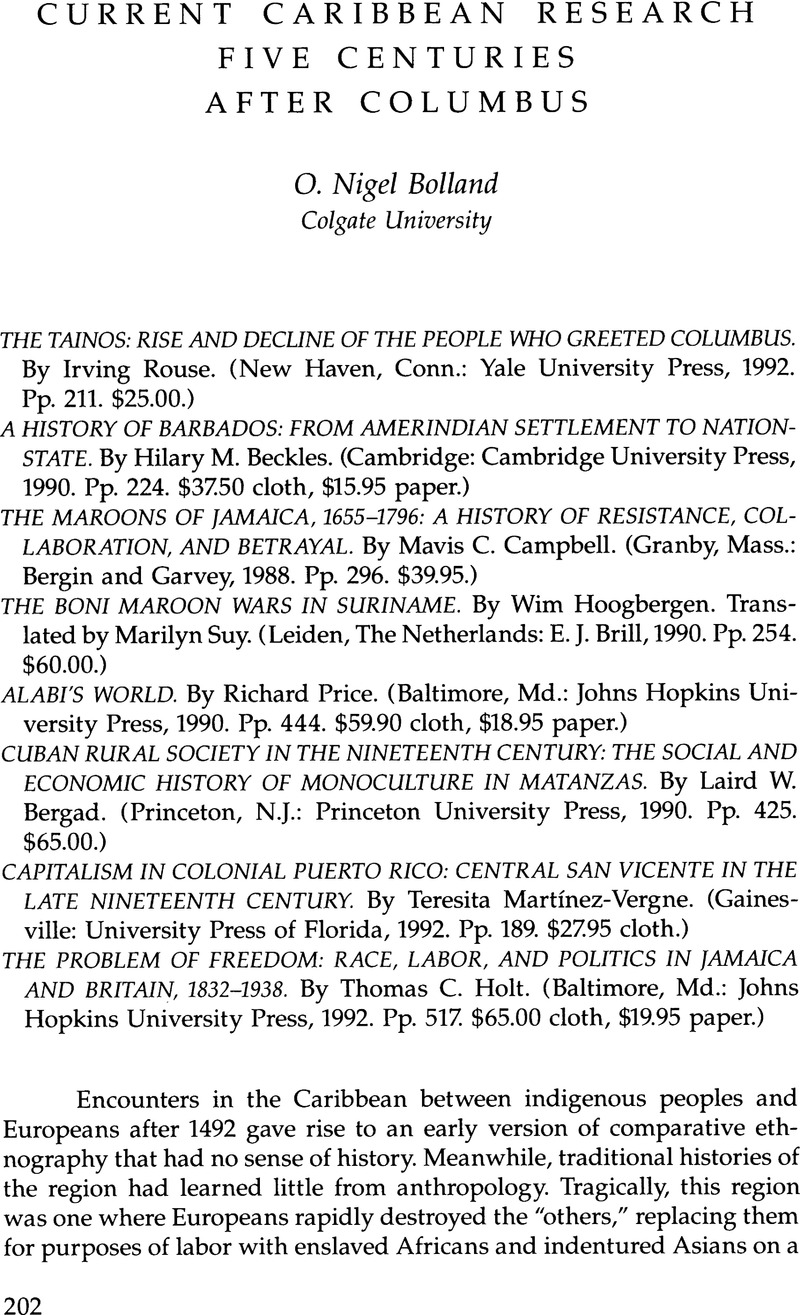Article contents
Current Caribbean Research Five Centuries After Columbus
Review products
Published online by Cambridge University Press: 05 October 2022
Abstract

- Type
- Review Essays
- Information
- Copyright
- Copyright © 1994 by the University of Texas Press
References
Notes
1. See, for examples, Beckles's White Servitude and Black Slavery in Barbados, 1627-1715 (Knoxville: University of Tennessee Press, 1989); and Natural Rebels: A Social History of Enslaved Black Women in Barbados (New Brunswick, N.J.: Rutgers University Press, 1989).
2. Richard Price, First-Time: The Historical Vision of an Afro-American People (Baltimore, Md.: Johns Hopkins University Press, 1983).
3. This work has already received much praise, including an award from the Caribbean Studies Association in 1992.
4. In this regard, see also Gary Urton, The History of a Myth: Pacariqtambo and the Origin of the Inkas (Austin: University of Texas Press, 1990).
5. Unfortunately, this and many other insightful commentaries are found among the 153 pages of notes at the end of the book, where they may be lost to many readers.
6. Laird Bergad, Coffee and the Growth of Agrarian Capitalism in Nineteenth-Century Puerto Rico (Princeton, N.J.: Princeton University Press, 1983).
7. Rebecca J. Scott, Slave Emancipation in Cuba: The Transition to Free Labor, 1860-1899 (Princeton, N.J.: Princeton University Press, 1985); Robert L. Paquette, Sugar Is Made with Blood: The Conspiracy of La Escalera and the Conflict between Empires over Slavery in Cuba (Middletown, Conn.: Wesleyan University Press, 1988).
8. James L. Dietz, Economic History of Puerto Rico: Institutional Change and Capitalist Development (Princeton, N.J.: Princeton University Press, 1986), 36.
9. See my “Systems of Domination after Slavery: The Control of Land and Labor in the British West Indies after 1838,” Comparative Studies in Society and History 23, no. 4 (1981):591-619; “Reply to William A. Green's 'The Perils of Comparative History,” Comparative Studies in Society and History 26, no. 1 (1984):120-25; and Bolland, “The Politics of Freedom in the British Caribbean,” in The Meaning of Freedom: Economics, Politics, and Culture after Slavery, edited by Frank McGlynn and Seymour Drescher (Pittsburgh, Pa.: University of Pittsburgh Press, 1992), 113-46. See also Woodville K. Marshall, “The Post-Slavery Labour Problem Revisited,” 1990 Elsa Goveia Memorial Lecture (Mona, Jamaica: University of the West Indies, 1991). None of these works are cited in Holt's extensive bibliography.
10. This point was made many years ago in an article not cited by Holt. See Richard Frucht, “A Caribbean Social Type: Neither ‘Peasant’ nor ‘Proletarian,‘” Social and Economic Studies 13, no. 3 (1967):295-300.
11. Walter Rodney, “Plantation Society in Guyana,” Review 4 (1981):643-66 (published by the Fernand Braudel Center at SUNY, Binghamton); as cited in Francisco A. Scarano, “Labor and Society in the Nineteenth Century,” in The Modern Caribbean, edited by Franklin W. Knight and Colin A. Palmer (Chapel Hill: University of North Carolina Press, 1989), 69.
12. This point was made in similar terms at a conference that Holt and I attended at the University of Pittsburgh in 1988. See Bolland, “The Politics of Freedom,” 138-43.
13. A fine study of these aspects of society in Guyana (not cited by Holt) is Brian L. Moore, Race, Power, and Social Segmentation in Colonial Society: Guyana after Slavery, 1838-1891 (New York: Gordon and Breach, 1987).
14. On the relation of “resistant response” to the process of cultural development in the Caribbean, see, for example, Sidney W. Mintz, Caribbean Transformations (Chicago, Ill.: Aldine, 1974), 131-79; and Jean Besson, “Freedom and Community: The British West Indies,” in The Meaning of Freedom, 183-219.
15. These include a study (not cited by Holt) by one of the chief Jamaican labor leaders of the time. See Richard Hart, Rise and Organise: The Birth of the Workers and National Movements in Jamaica (1936-1939) (London: Karia, 1989).
16. See Sidney W. Mintz's classic article, “The Caribbean as a Socio-Cultural Area,” Journal of World History 9, no. 4 (1966):912-37.
- 1
- Cited by


